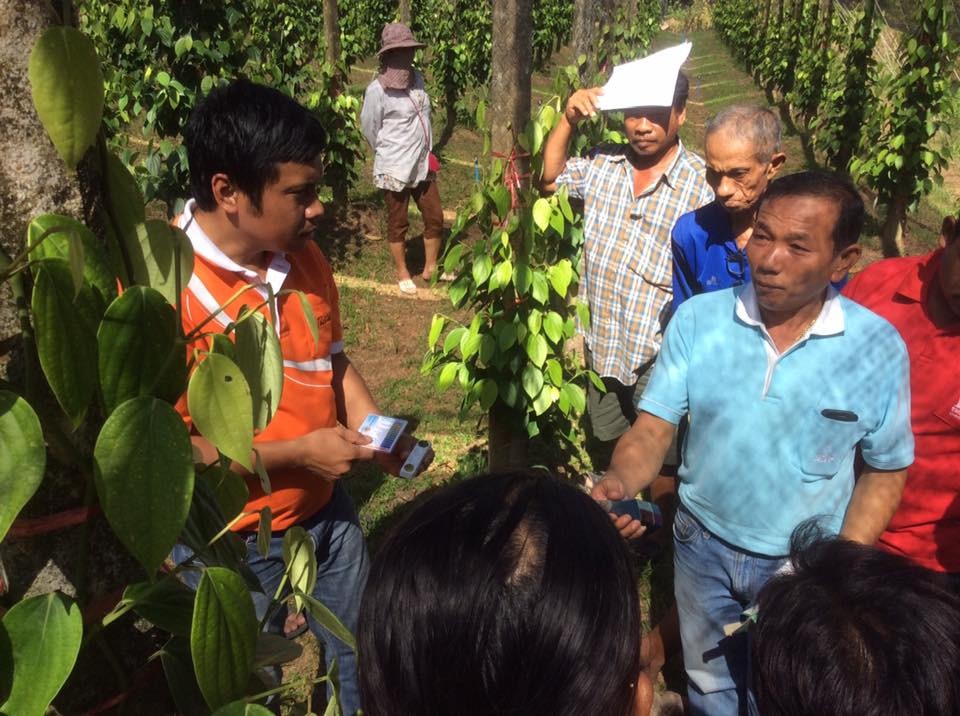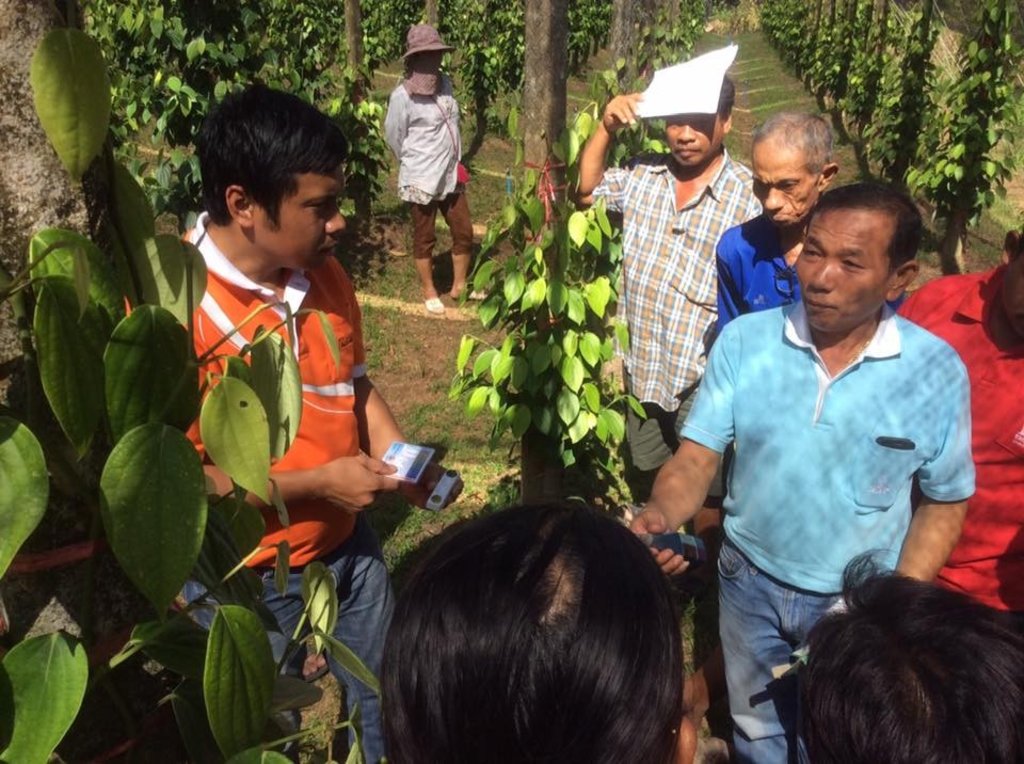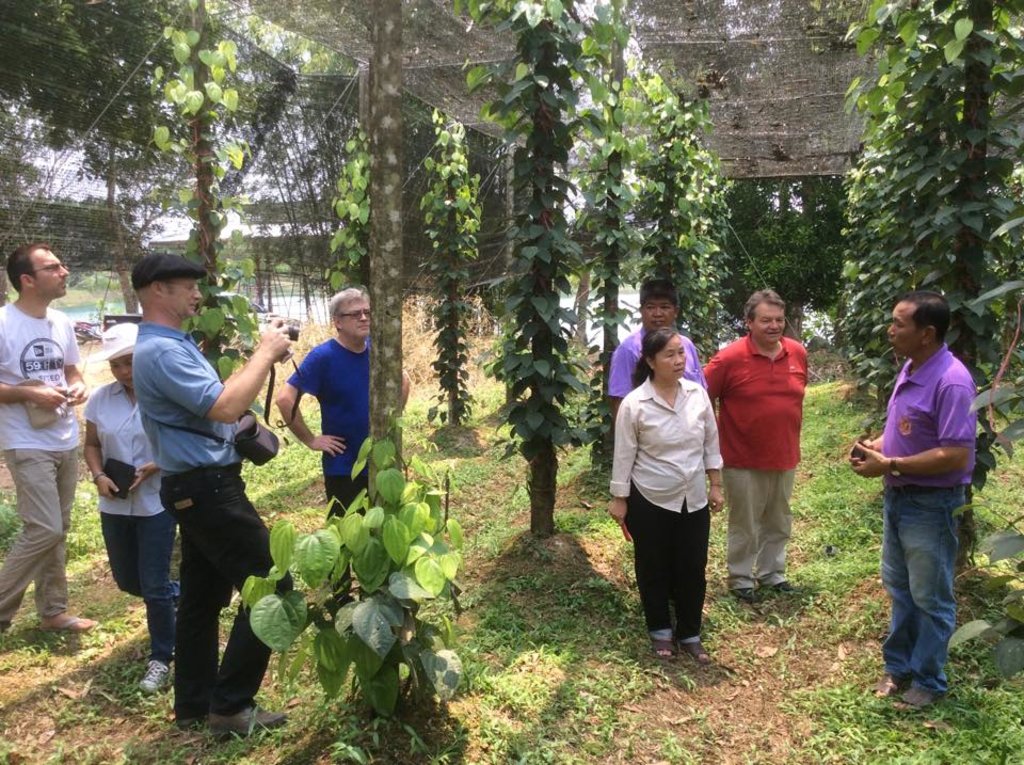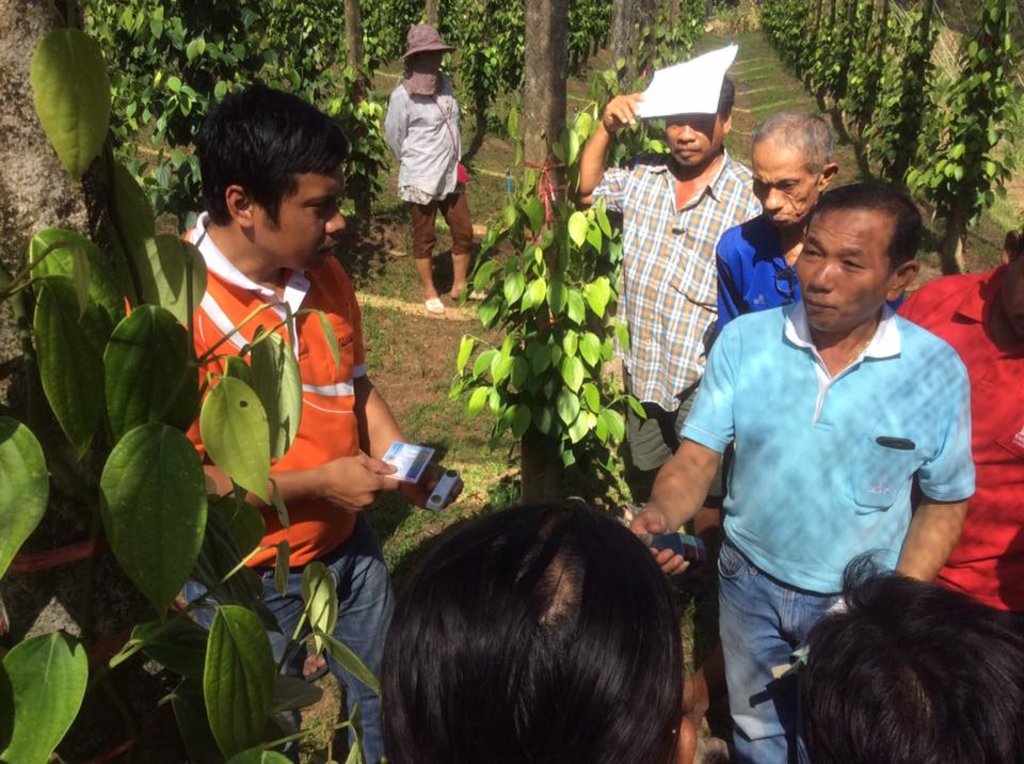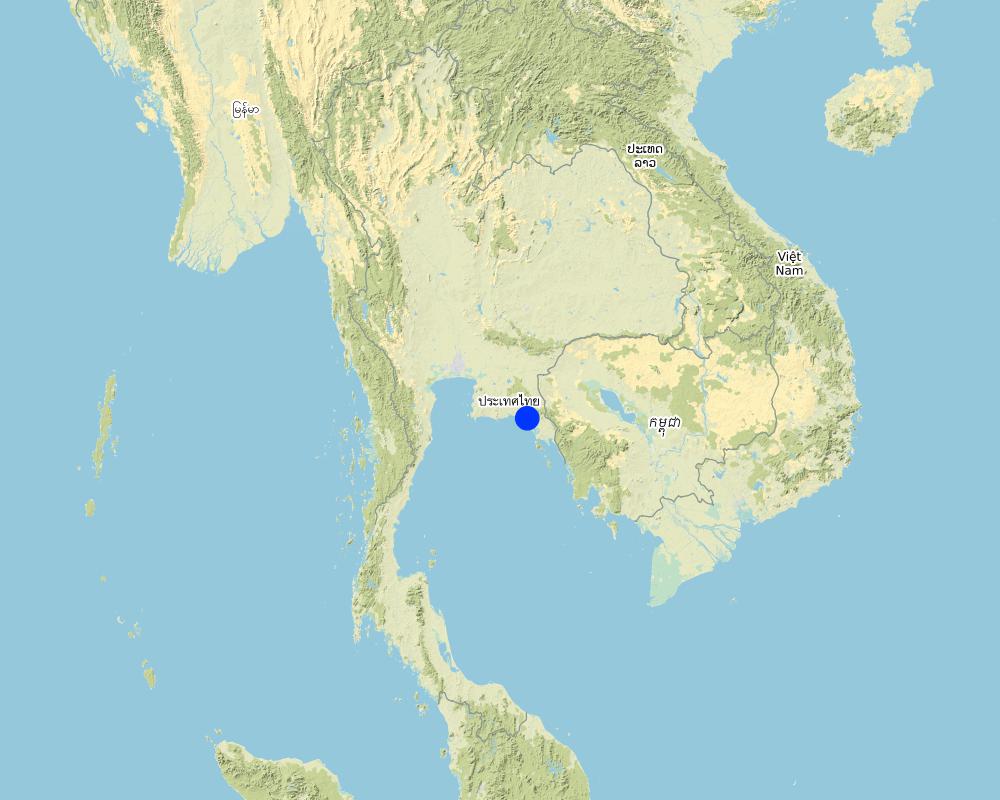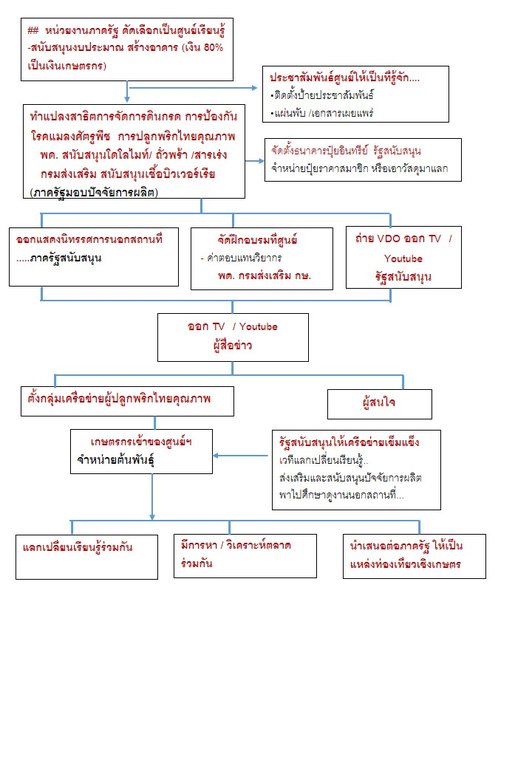Center of Soil, Water and Fertilizer for Quality Pepper Production (Thailand) Wangtanod Land Development Center [Thailand]
- Creation:
- Update:
- Compiler: Kukiat SOITONG
- Editor: –
- Reviewers: Rima Mekdaschi Studer, Pitayakon Limtong, William Critchley
ศูนย์พัฒนาที่ดินวังโตนด
approaches_4247 - Thailand
View sections
Expand all Collapse all1. General information
1.2 Contact details of resource persons and institutions involved in the assessment and documentation of the Approach
Key resource person(s)
co-compiler:
ผู้รวบรวม:
Paipakvan Parichart
0-3721-0781 / 08-5920-8429
parichat19@hotmail.com / -
Prachinburi Land Development Station
135/1Moo5 Tambon Noenhom Muang District Prachinburi province
Thailand
extension officer:
Changthom Chalermchon
0-3932-2158 / 08-1872-9509
c.changthom@gmail.com / -
Chantaburi Provincial Extension Office
1196 Thachaleap road ,Tambon Natalad ,Muang District ,Chantaburi province 22000
Thailand
land user:
Kingmanee Boonchai
08-5217-3509 / -
- / -
Soil Doctor volunteer
25/2 Moo 7 Tambon Ramphan ,Thamai District,Chataburi province
Thailand
land user:
Kamonsinee
08-4781-2071 / -
pimg134082@gmail.com / -
farmer
44 Moo 4 Tambon Wangtanod ,Nayayarm District,Chanthaburi province
Thailand
land user:
Mette Jumrat
08-7032-4142 / -
- / -
farmer
24 Moo 4 Tambon Wangtanod ,Nayayarm District,Chanthaburi province
Thailand
1.3 Conditions regarding the use of data documented through WOCAT
When were the data compiled (in the field)?
03/10/2018
The compiler and key resource person(s) accept the conditions regarding the use of data documented through WOCAT:
Yes
2. Description of the SLM Approach
2.1 Short description of the Approach
The Centre of soil, water, fertilizer and production of quality peppers in Wang Tanod district is a learning point for acid soil improvement and strengthening quality pepper production and networking in Chanthaburi province.
2.2 Detailed description of the Approach
Detailed description of the Approach:
The center is a learning point on the shallow lateritic soil/acid soils where farmers want to produce quality peppers. The owner of the center is Mr Boonchai Kingmanee who is proud of his achievements in producing quality peppers on his poor soil. He is ready and willing to share what he knows with the neighbouring communities: and he is a good trainer. His objective is to transfer knowledge about acid soil improvement and production of quality peppers - and to build up a network in Chanthaburi Province. The center’s role includes: knowledge transfer, training, exhibitions, publications, networking, promotion, distributing products (such as pepper seedlings, fresh and dry pepper products), public relations and marketing analysis. The center works with government agencies, such as the Land Development Department (LDD), the Department of Agricultural Extension (DOAE) and others. It began with site selection and grouping of successful pepper growers. Support for the center has covered construction of buildings, document production, publications, billboards, outdoor exhibition, and honorariums for farmer trainers. Public relations for the center is through various methods including an exhibition, TV, social media as well as through the government agencies’ media.
Demonstrations and training programs covering acid soil improvement and good practice for better quality pepper production, as well as organic fertilizer production, and pest control management, have been done through the support of government agencies. The high-quality pepper producers’ network was established under the support of the government; farmers who visit the center become members of the network automatically. The network is a forum for members to exchange knowledge, share inputs given by providers and perform market analysis data exchange etc. To strengthen the farmers’ network, the government agencies support the activities of the group such as providing knowledge, providing a forum for exchanging knowledge, providing inputs and promotion of pepper development.
An organic fertilizer bank was established as a mechanism to group the farmer members to produce compost. Members exchange compost for their organic farm residues. Last but not least, to strengthen the learning center, it invites interested parties to submit project proposals such as the center development program, and the eco-tourism project.
The project has resulted in impacts with which farmers are pleased. First, the center is a place that can help farmers solve their farming problems - it thus strengthens their occupation. Second, networking is a practical mechanism that farmers help each other in both production and marketing issues. Finally, it has become a place for farmers’ relaxation/recreation. They are happy when they have a chance to join the meetings and/or exchange knowledge among themselves.
2.3 Photos of the Approach
2.4 Videos of the Approach
Comments, short description:
-
Date:
10/05/2016
Location:
-
Name of videographer:
Land development Department
Comments, short description:
-
Date:
03/04/2017
Location:
-
Name of videographer:
Rakbankerd.com
2.5 Country/ region/ locations where the Approach has been applied
Country:
Thailand
Region/ State/ Province:
Chantaburi
Further specification of location:
35 Moo 4 Tambon Wangtanod ,Nayayarm District ,Chantaburi province
Comments:
The Centre of soil, water, and fertilizer for quality pepper production at Wang Tanod district, Chanthaburi Province, is a learning center on shallow lateritic soil/acid soils where the farmers want to produce quality peppers. The owner of the center is a knowledgeable and proud of the success of his practices on making quality pepper production on his poor soil. He is ready and willing to transfer what he knows to the neighbouring communities as he is a good trainer. The objective of the Centre is to transfer the knowledge of acid soil improvement to produce quality peppers and build up the quality pepper production networking in Chanthaburi province
Map
×2.6 Dates of initiation and termination of the Approach
Indicate year of initiation:
2013
If precise year is not known, indicate approximate date when the Approach was initiated:
less than 10 years ago (recently)
Comments:
Got support from government agencies under Ministry of Agriculture such as agricultural inputs, finance, media and publication aids.
2.7 Type of Approach
- project/ programme based
2.8 Main aims/ objectives of the Approach
The objectives of the Center of Soil, Water and Fertilizer and Production of Quality Pepper at Wang Tanod District, Chanthaburi Province are to transfer knowledge about acid soil improvement in order to produce quality peppers and to build up a quality pepper production network in Chanthaburi Province.
2.9 Conditions enabling or hindering implementation of the Technology/ Technologies applied under the Approach
social/ cultural/ religious norms and values
- enabling
No effect to technology transfer/adoption
availability/ access to financial resources and services
- enabling
Farmers are aware of the acid soil problems and they normally buy dolomite to apply in acid soils by themselves
institutional setting
- enabling
Under the support of Provincial Extension Office, Land Development Department etc
collaboration/ coordination of actors
- enabling
Integration planning of the organizations under the Ministry of Agriculture and Cooperatives to support the acid soil pepper plantation and related issues.
legal framework (land tenure, land and water use rights)
- enabling
No objection to the technology /approach
policies
- enabling
To protect the land from any degradation process, or reduce/restore degraded land, is one strong component of the National Policy.
land governance (decision-making, implementation and enforcement)
- enabling
Suitable crop cultivation based on Land Management Policy.
knowledge about SLM, access to technical support
- enabling
Acid soil improvement by using dolomite has been widely adopted. The LDD provides soil test services, dolomite subsidy, sets up a learning center for the community, and runs a compost bank program.
markets (to purchase inputs, sell products) and prices
- enabling
There is a need for markets to buy inputs and sell peppers; good prices of pepper are an incentive in operating the plantation.
- hindering
High price of the dolomite in the market needs soil analytical data for proper application rates
workload, availability of manpower
- hindering
Shortage of labour, aging of farmers.
3. Participation and roles of stakeholders involved
3.1 Stakeholders involved in the Approach and their roles
- local land users/ local communities
farmers
Acid soil problem is at the top of the priority list, and needs to be solved before going to the next step of production
- community-based organizations
Provincial and Local Administration Authority
project supporter, financial support
project supporter, financial support
- SLM specialists/ agricultural advisers
LDD
Soil service, dolomite subsidy, learning center establishment, trainer
- teachers/ school children/ students
Burapha University
to be a lecture, demonstration plot
- national government (planners, decision-makers)
LDD
Should be selected as farmers representative and join international events.
If several stakeholders were involved, indicate lead agency:
Increase the efficiency of pepper production to reduce the effect of FTA during 2013-2014
3.2 Involvement of local land users/ local communities in the different phases of the Approach
| Involvement of local land users/ local communities | Specify who was involved and describe activities | |
|---|---|---|
| initiation/ motivation | interactive | land owner and local officers |
| planning | interactive | land owner and local officers |
| implementation | local Farmers and local government services | |
| monitoring/ evaluation | interactive | land owner and local officers |
| - | - |
3.3 Flow chart (if available)
Description:
The working process of the center is: knowledge transfer, training program, exhibition, publication, networking, promotion, distributing the products (such as pepper seedlings, fresh and dry pepper products), public relations and marketing analysis data presentation.
The working steps of the center begins with the government agencies, such as the Land Development Department (LDD), the Department of Agricultural Extension (DOAE) and other related agencies. Then select the site and successful pepper growers to form a learning center, the support for the center will be the construction of some buildings, document production, publications, billboards, outdoor exhibition, and honorarium for farmer trainers. The public relations of the center is being done through the exhibition, billboard, TV program, and online promotion via Facebook, Youtube, plus public relations through the government agencies’ media.
The demonstration of acid soil improvement in practice, good practice for better quality pepper production, organic fertilizer bank, pest control management, all have been done under the support of government agencies as well as several training programs and field visits for both personal and groups. The better-quality pepper producers’ network was established under the support of the government; farmers who visit the center become members of the network automatically. The network is a forum for members to exchange knowledge, share inputs given by providers and perform market analysis data exchange etc.
To strengthen the farmers’ network, the government agencies support the activities of the group such as providing knowledge, providing a forum for exchanging knowledge, providing inputs and promotion of pepper development. The distribution of pepper and pepper products was set up such as pepper seedlings, pepper products etc.
The organic fertilizer bank was established as a mechanism to group the farmer members to produce compost. Members of the bank will exchange for the compost with their organic farm residues that they have.
Author:
-
3.4 Decision-making on the selection of SLM Technology/ Technologies
Specify who decided on the selection of the Technology/ Technologies to be implemented:
- all relevant actors, as part of a participatory approach
Explain:
local farmers group are understanding their problems, crop production problems, low yield etc. They got the solutions from the technology transfer from both public and farmers
Specify on what basis decisions were made:
- personal experience and opinions (undocumented)
4. Technical support, capacity building, and knowledge management
4.1 Capacity building/ training
Was training provided to land users/ other stakeholders?
Yes
Specify who was trained:
- land users
If relevant, specify gender, age, status, ethnicity, etc.
Training or technology transfer to farmers, soil volunteer doctors and other interested persons
Form of training:
- farmer-to-farmer
- demonstration areas
- public meetings
Subjects covered:
Using the LDD soil improvement products
Comments:
Lecture , field visiting through the learning center
4.2 Advisory service
Do land users have access to an advisory service?
Yes
Specify whether advisory service is provided:
- on land users' fields
- at permanent centres
Describe/ comments:
Interested farmers may visit to learn and ask for advice from the farmer-cum-owner of the center or may call to phone no. 085-2788035.
4.3 Institution strengthening (organizational development)
Have institutions been established or strengthened through the Approach?
- no
4.4 Monitoring and evaluation
Is monitoring and evaluation part of the Approach?
Yes
Comments:
LDD monitoring and evaluation esp. Soil test
If yes, is this documentation intended to be used for monitoring and evaluation?
Yes
Comments:
Monitoring and following up the use of the technology make more people receptive to the technology
4.5 Research
Was research part of the Approach?
No
5. Financing and external material support
5.1 Annual budget for the SLM component of the Approach
Indicate the annual budget for the SLM component of the Approach in US$:
9753.00
If precise annual budget is not known, indicate range:
- 2,000-10,000
Comments (e.g. main sources of funding/ major donors):
LDD and DOAE support the center’s construction, farm inputs, demonstration facilities and the operation of the compost bank
5.2 Financial/ material support provided to land users
Did land users receive financial/ material support for implementing the Technology/ Technologies?
Yes
If yes, specify type(s) of support, conditions, and provider(s):
LDD transfers the technology and provides dolomite subsidy. Provincial extension office, DOA center supports other farm inputs and advises under the FTA program
5.3 Subsidies for specific inputs (including labour)
- agricultural
| Specify which inputs were subsidised | To which extent | Specify subsidies |
|---|---|---|
| seeds | partly financed | 13,200 |
| fertilizers | partly financed | 100,000 |
| Dolomite, microorganisms to produce LDD 2 compost maker, Molasses and a fermentation tank: 22,800 THB | partly financed | 22,800 |
If labour by land users was a substantial input, was it:
- rewarded with other material support
Comments:
-
5.4 Credit
Was credit provided under the Approach for SLM activities?
No
5.5 Other incentives or instruments
Were other incentives or instruments used to promote implementation of SLM Technologies?
Yes
If yes, specify:
1. Sells pepper seedlings; 2. Provides honorarium; 3. Makes the products better known, thus increasing the volume of sale; 4 Gives awards.
6. Impact analysis and concluding statements
6.1 Impacts of the Approach
Did the Approach enable evidence-based decision-making?
- No
- Yes, little
- Yes, moderately
- Yes, greatly
Most of the farmers have been trained and they are aware of the acid soil problems and give the priority to the improvement; some even buy the dolomite by themselves.
Did the Approach help land users to implement and maintain SLM Technologies?
- No
- Yes, little
- Yes, moderately
- Yes, greatly
Farmers get a good result after improving the soil, i.e. they get hiigher productivity.
Did the Approach improve coordination and cost-effective implementation of SLM?
- No
- Yes, little
- Yes, moderately
- Yes, greatly
After establishing the farmers’ network, information and resources exchange among members of the network has occurred.
Did the Approach improve knowledge and capacities of land users to implement SLM?
- No
- Yes, little
- Yes, moderately
- Yes, greatly
There have been knowledge exchanges, field visits and a number of training programs.
Did the Approach improve knowledge and capacities of other stakeholders?
- No
- Yes, little
- Yes, moderately
- Yes, greatly
There have been knowledge exchanges and field visits to some successful sites – so it is possible that other stakeholders also obtain some new knowledge.
Did the Approach build/ strengthen institutions, collaboration between stakeholders?
- No
- Yes, little
- Yes, moderately
- Yes, greatly
A number of farmers groups have been strengthened.
Did the Approach encourage young people/ the next generation of land users to engage in SLM?
- No
- Yes, little
- Yes, moderately
- Yes, greatly
There has been certain knowledge distribution from the present SLM technology users to the neighboring farmers, making some new generation farmers to be aware of. Additionally, there are some TV channels that show the technology transfer via their programs, as well as some online social media (such as Youtube) that show the SLM technologies, plus certain exhibitions too.
เทคโนโลยีช่วยฟื้นฟูและปรับปรุงดินกรด เกษตรกรผู้ใช้เทคโนโลยีส่วนใหญ่หันมาใช้สารอินทรีย์ลดการใช้สารเคมีทางการเกษตร ทำให้ได้ผลผลิตอาหารที่ปลอดภัย
Did the Approach improve access to markets?
- No
- Yes, little
- Yes, moderately
- Yes, greatly
Yes, with the higher quality products, they better meet the markets’ demand.
Did the Approach lead to employment, income opportunities?
- No
- Yes, little
- Yes, moderately
- Yes, greatly
Yes, more local labourers are being employed
6.2 Main motivation of land users to implement SLM
- increased production
Improve soil pH which suitable for crop growing,increase yield ,income ,increase production area
- increased profit(ability), improved cost-benefit-ratio
yield increase, higher price, farmers got more return
- reduced land degradation
better soil, increase pH
- affiliation to movement/ project/ group/ networks
Farmers grouping, pepper growers networking
- enhanced SLM knowledge and skills
Technology can show the results that make more people want to learn and practice more widely
6.3 Sustainability of Approach activities
Can the land users sustain what has been implemented through the Approach (without external support)?
- yes
If yes, describe how:
Farmers can do on their own. They do not need to wait for the support from the government.
6.4 Strengths/ advantages of the Approach
| Strengths/ advantages/ opportunities in the land user’s view |
|---|
| 1. There is a source of learning to solve the occupation problems. |
| 2. It provides more secure profession to the pepper growers, as they now have their own technology, solution and network to operate. |
| 3. The place where farmers meet and exchange knowledge and information has become a recreation site as well. |
| 4. Continued support from the government. |
| 5. Have more opportunity to learn some new things. |
| Strengths/ advantages/ opportunities in the compiler’s or other key resource person’s view |
|---|
| 1) Agencies under MOAC give priority to the problems and support the program. |
6.5 Weaknesses/ disadvantages of the Approach and ways of overcoming them
| Weaknesses/ disadvantages/ risks in the land user’s view | How can they be overcome? |
|---|---|
| - | - |
| - | - |
| - | - |
| Weaknesses/ disadvantages/ risks in the compiler’s or other key resource person’s view | How can they be overcome? |
|---|---|
| - | - |
| - | - |
| - | - |
7. References and links
7.1 Methods/ sources of information
- interviews with land users
5
- interviews with SLM specialists/ experts
1
7.2 References to available publications
Title, author, year, ISBN:
-
Available from where? Costs?
-
7.3 Links to relevant information which is available online
Title/ description:
-
URL:
-
Links and modules
Expand all Collapse allLinks
No links
Modules
No modules


